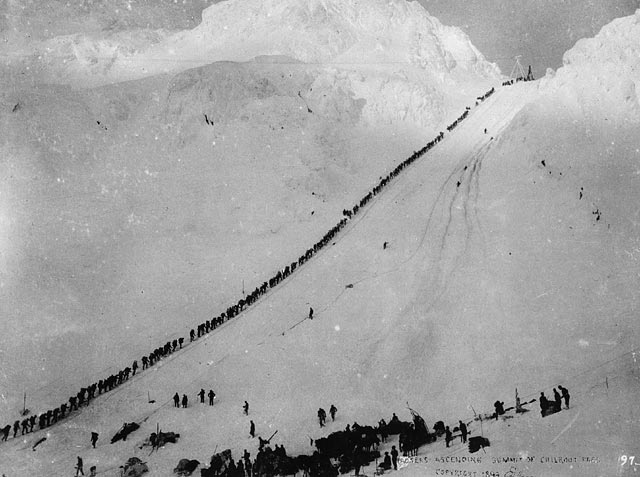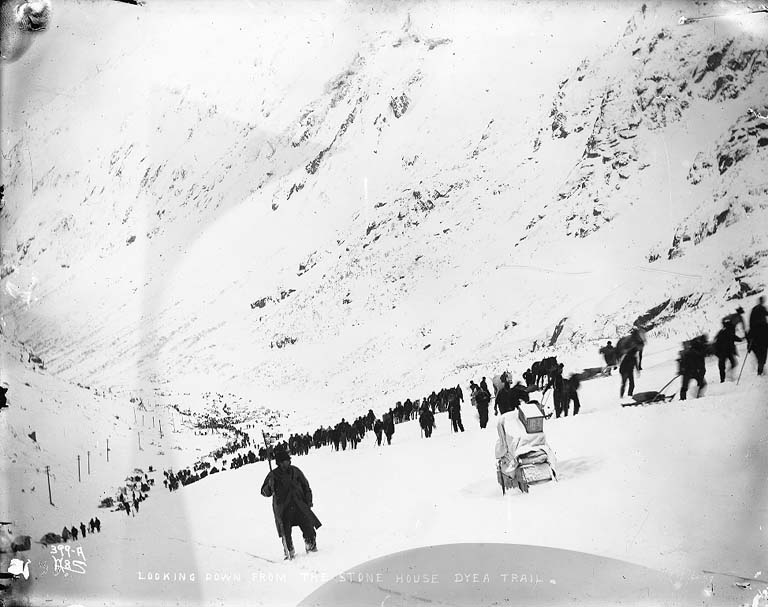At the peak of its use, the Chilkoot Trail served as an alternative route to the longer, albeit less treacherous, White Pass Trail to Dawson City, Yukon Territory, where gold was struck in 1896. Despite its reputation as a dangerous trail, the Chilkoot became to most popular route as it was the most direct and least expensive. The trail was so dangerous, in fact, that Canada's Northwest Mounted Police required all stampeders to carry one ton of goods- the estimated amount of gear to allow a prospector to survive one year. Among the recommended items were 150 lbs. of bacon, 5 yards of mosquito netting, 2 pairs snag-proof heavy rubber boots, 1 dozen heavy wool socks, and, of course, a pan for mining gold. Packing one ton of goods required that each prospector shuttle their goods a few hundred meters at a time, before turning around to make the trip again with another 50 lbs. of material. It was estimated that each stampeder covered the trail between 30-40 times in total after this arduous process was complete.
 Most stampeders covered the 33-mile trail in the winter, as the snow cover made the terrain easier to navigate. 16 miles into the trail, prospectors reached "The Golden Stairs," a 45-degree slope that was so steep, the bare boulders were often exposed, posing an additional challenge. In case it wasn't difficult enough, there are two false summits, which often prompted a premature celebration.
Most stampeders covered the 33-mile trail in the winter, as the snow cover made the terrain easier to navigate. 16 miles into the trail, prospectors reached "The Golden Stairs," a 45-degree slope that was so steep, the bare boulders were often exposed, posing an additional challenge. In case it wasn't difficult enough, there are two false summits, which often prompted a premature celebration. I am preparing to hike the Chilkoot Trail this Friday with 7 Park Rangers that I have met since coming to Skagway last month. When they invited me to join them, I hardly hesitated- who better to hike with than a group of well-trained, experienced Rangers? Although, as the trip nears, and as I learn more about grizzly safety, navigating in alpine conditions, and preparing for extreme weather, I am beginning to realize this is going to be a trek unlike any I've ever done before.
I am preparing to hike the Chilkoot Trail this Friday with 7 Park Rangers that I have met since coming to Skagway last month. When they invited me to join them, I hardly hesitated- who better to hike with than a group of well-trained, experienced Rangers? Although, as the trip nears, and as I learn more about grizzly safety, navigating in alpine conditions, and preparing for extreme weather, I am beginning to realize this is going to be a trek unlike any I've ever done before.Snow covers the trail for most of the year, and while avalanches are rare, much of the trail is above the treeline and is characterized by extreme weather.
 We are planning on hiking 13 miles to Sheep Camp on Day 1, 10 miles to Deep Lake on Day 2, and 10 miles to Bennett on Day 3, where we will have the next day to explore before taking the White Pass- Yukon Route Railroad home to Skagway, where warm beds and hot showers will be waiting for us.
We are planning on hiking 13 miles to Sheep Camp on Day 1, 10 miles to Deep Lake on Day 2, and 10 miles to Bennett on Day 3, where we will have the next day to explore before taking the White Pass- Yukon Route Railroad home to Skagway, where warm beds and hot showers will be waiting for us.
Sending hugs your way - hope the trip was safe. I am sure it was spectacular and a feast for the senses!
ReplyDelete